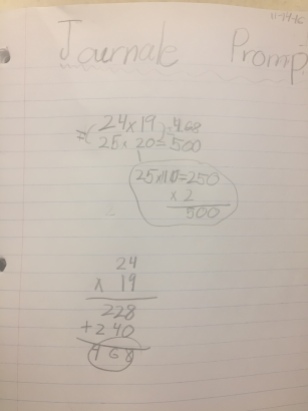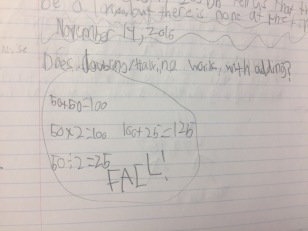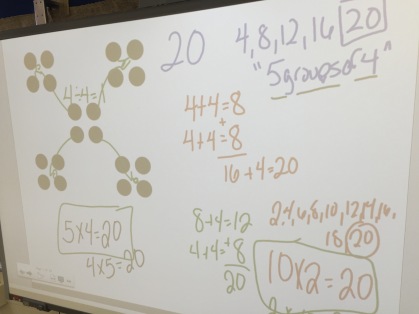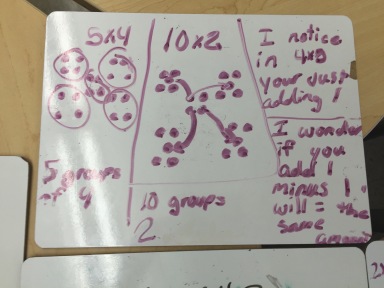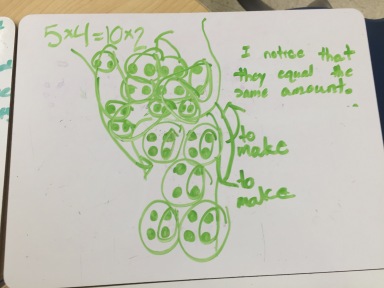As a teacher, curiosity around students’ mathematical thinking was the driving force behind the teaching and learning in my classroom. To better understand what they were thinking, I needed to not only have great, accessible problems but also create opportunities for students to openly share their ideas with others. It only makes sense that when I learned about routines that encouraged students to share the many ways they were thinking about math such as Number Talks, Notice and Wonder, and Which One Doesn’t Belong?, I was quick to go back to the classroom and try them with my students. It didn’t matter which unit we were in or lesson I had planned for that day, I plopped them in whenever and wherever I could because I was so curious to hear what students would say. Continue reading
Category Archives: Number Talks

Number Talk: Which Numbers Are Helpful?
I think Number Talks are such a powerful routine in developing students’ fluency and flexibility with operations, but maybe not for the reason most think. One of the most highlighted purposes of a Number Talk is the ability to elicit multiple strategies for the same problem, however, an even more important goal for me during a Number Talk is for students to think about the numbers they are working with before they begin solving. And then, as they go through their solution path, think about what numbers are helpful in that process and why.
The struggle with trying to dig deeper into that thinking is simply, time. If the opportunity arises, I ask students about their number choices during the Talk but often students just end up re-explaining their entire strategy without really touching on number choices. Not to mention the other 20ish students start losing interest if they take too long. I do think it is a particularly tough question if students are not used to thinking about it and when the thinking happens so quickly in their head, they don’t realize why they made particular choices.
Last week in 2nd grade I did a Number Talk with two problems, one addition and one subtraction. During the addition talk, I noticed students using a lot of great decomposition to make friendly numbers (the term they use to describe 10’s and 100’s).

During the subtraction problem, I saw the same use of friendly numbers, however in this one I actually got 100 as an answer. My assumption was because the student knew he was using 100 instead of 98, but got stuck there so went with 100 as the answer. I was really impressed to see so many strategies for this problem since subtraction is usually the operation teachers and I talk endlessly about in terms of where students struggle. I find myself blogging on and on about subtraction all of the time!
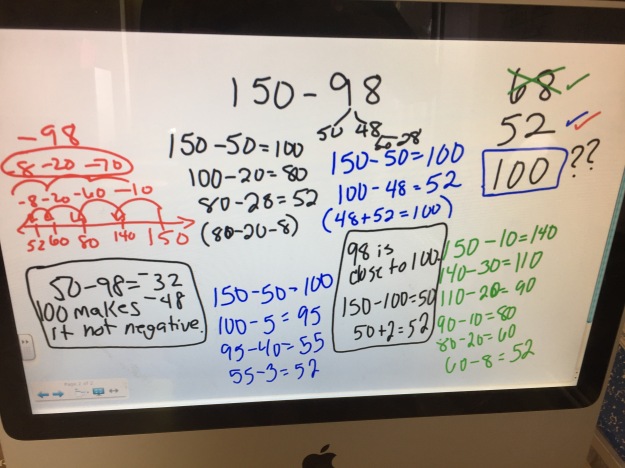
When the Number Talk ended, I looked at the board and thought if my goal was to elicit a lot of strategies, then I was done – goal met. However, I chose the numbers in each problem for a particular reason and wanted students to dig more into their number choices.
This is where I find math journals to be so amazing. They allow me to continue the conversation with students even after the Number Talk is finished.
I went back to the 100, circled it and told the class that I noticed this number came up a lot in both of our problems today. I asked them to think about why and then go back to their journal to write some other problems where 100 would be helpful.
Some used 100 as a number they were trying to get to, like in this example below. I really liked the number line and the equations that both show getting to the 100, but in two different ways.

This student got to 100 in two different ways also. I thought this was such a clear explanation of how he decomposed the numbers to also use 10’s toward the end of their process as well.

This student used the 100 in so many ways it was awesome! She got to 100, subtracted by 100 and adjusted the answer, and then added up to get to 100.

While the majority of the students chose to subtract a number in the 90’s, this student did not which I find so incredibly interesting. I would love to talk to him more about his number choices!

I didn’t give a clear direction on which operation I wanted them to use, so while most students chose subtraction because that was the problem we ended on, this one played around with both, with the same numbers. I would love to ask this student if 100 was helpful in the same or different way for the two problems.

As I said earlier, this is a really tough thing for students to think about because it is looking deeper into their choices and in this case apply it to a new set of numbers. This group was definitely up for the challenge and while I love all of the work above, these two samples are so amazing in showing the perseverance of this group.
In this one, you can see the student started solving the problem and got stuck so she drew lines around it and went on to subtract 10’s until she ran out of time. I love this so much.

This student has so much interesting work. It looks as if he started with an addition problem involving 84, started adding, then changed it to subtraction and got stuck.

This is what I call continuing the conversation. They wrote me notes to let me know Hey, I am not done here yet and I am trying super hard even though there are mistakes here. That is so powerful for our learners. So while there was no “right” answer to my prompt, I got a glimpse into what each student was thinking after the Number Talk which is often hard to do during the whole-group discussion.
If you want to check out how I use journals with other Number Routines, they are in the side panel of all of my videos on Teaching Channel.
The Equal Sign
True or False?
5 = 5
5 = 4 + 2
2 + 3 = 1 + 4
After reading so much about the meaning of the equal sign and equality in books such as Thinking Mathematically and About Teaching Mathematics , I anticipated students may think each was false for different reasons…..
5 = 5: There is no operation on the left side.
5 = 4 + 2: The sum comes first or 4+2 is not 5.
2 + 3 = 1 + 4: there is an operation on both sides or because 2+3 =5 (and ignore the 4) or because 2+3+1 ≠ 4.
While I anticipated how students may respond, I was so intrigued by the number of students (probably about 75%) that said false for 5=5. They were about split on the second one, but for many reasons – not many of them being that 5 ≠ 6. The final one left many confused, in fact one student said, “Well now you are just trying to confuse people by putting two plus signs.” So cute.
As they explained their reasoning, my mind was reeling….
- What questions do I ask to get them to:
- Think about what the symbols mean?
- Talk about what is the same?
- Realize the equal sign in the first one is not a plus sign, so there is no answer of 10?
- See the equal sign to not mean “the answer is next”?
- What wording do I use for the equal sign?
- “The same as” felt wrong because the sides do not look the same in both cases….so, is “Is the same amount” a helpful way for them to think about it?
I got back to my room and starting thinking about what learning experiences would be helpful for students in building their understanding of the equal sign? I talked through it with some colleagues at school and reached out to those outside of school, I needed some serious help!
I started playing around with some cubes and realized how interestingly my thinking changed with each one. I didn’t take a pic of those cubes so I recreated them virtually to talk thru my thinking here.
The first set represents 5 = 5. I can see here where “the same as” works for the equal sign because there are 5 and they are all yellow. But what if I put 5 yellows on the left and 5 red on the right? Then they are the same quantity, but do not look the same.
The second set represents 2+3=5 and is definitely the one students are most comfortable seeing and representing as an equation. It looks and feels like composition to me so I can definitely see why student think the equal sign means “makes” or “the total is.” It looks like 2 and 3 more combine to make 5.
Something interesting happened with the green set. I made two sets of 5 and then broke one set to make the right side – felt like decomposition. I can see why it would feel differently to students. I also realized that when I look at them, I look left to right and much of that lends itself to the way I was thinking about what was happening.
The last set I made by taking my 2 sets of 5 connected cubes and breaking each set differently. Again, “the same as” doesn’t work for me here really well either because they don’t look the same.

Still thinking of next steps because I always like to put context into play with these types of things, but I am finding that very difficult without forcing the way students represent their thinking which I don’t want to do.
Right now, things I am left thinking about before planning forward:
- What do students attend to when we ask if things are the same?
- Our language and recording is SO incredibly important.
- How can these ideas build in K-1 to be helpful in later grades?
- If I am thinking of moving students from a concrete to more abstract understanding, how does that happen? Is it already a bit abstract in the way the numbers are represented?
- Do we take enough time with teachers digging into these ideas? [rhetorical]
I look forward to any thoughts! So much learning to do!
1st Gr Number String: Missing Number
Yesterday, I wrote a quick post as I was trying to decide which of two number talks I should do with a 1st grade class. I got some great feedback and went with the first one in the post! It was amazing and completely evident that the teacher, Ms. Williams, does a great job asking students to share their thinking regularly. The students were so clear in explaining their reasoning and asking questions of one another.
The first problem drew out exactly what I was hoping and more. One student shared counting on and a few students shared how they decomposed the 4 and added 2 and then 2 more. I was not expecting the use of a double, but two students used 8+8 in their reasoning. The use of their “double fact” reminded me of the solving equations conversations I have with Michael Pershan but in a much more sense-making way than I personally think about it. The students said they “knew 4 and 4 made 8 so they took 4 away and that changed the answer.” I tried to get out of them that they subtracted the 4 from the 16 as well, but it just made sense to them the 16 changed to 12 because he subtracted 4 from the 8. I am so glad I videoed this talk because I want to talk more about it after I re-watch it!
The second problem was as tricky, as I anticipated, and split the class between the answers 1 and 9. The students seemed very used to having the difference on the lefthand side of the equal sign which is great, but some still wanted to add 1 to the 4 instead of subtract the 4 from the missing number. I moved on to the final question because we were at a bit of a standstill at this point. Hindsight, I wish I did that problem last, but I had them journal about it after the talk.

The final problem, which I wish was my first problem – what was I thinking in this order? – was great! They decomposed the 5, made 10 and talked their way through the two incorrect responses.

I asked them to journal about the second problem when we finished. The prompt was to explain which answer, 9 or 1, they thought it was and why. Here are few examples:






I think I would love to post the following string (all at once) on the board to start tomorrow’s lesson:
? – 4 = 5
5 = ? – 4
? + 4 = 5
5 = ? + 4
Ask what the question mark is in each one and which equations seem most similar.
Such a great day in 1st grade!
True or False Multiplication Equations
Today, I was able to pop into a 3rd grade classroom and have some fun with a true or false equation routine! This routine has become one of my favorites, not only for the discussion during the activity, but more for the journals after the talk. I haven’t figured out quite how to use them with the students, but it gives me such great insight into their understandings that I would love to think about a way to have students reflect on them in a meaningful way. I keep asking myself, what conjectures or generalizations could stem from this work?
I started with 4 x 3 = 3 + 3 + 3 + 3 to get students thinking about the meaning of multiplication and how we can solve for a product using repeated addition. I followed 6 x 4 = 8 + 8 + 4 to see how students talked about the 8’s on the right side. They could explain why it was false by either solving both sides or reasoning about the 8’s as two 4’s in some way.
My final problem was the one below, 8 x5 = 2 x 5 + 2 x 5 + 20. I chose this one because I wanted students to see an equation with multiplication on both sides. Up to this point, I structured them to be multiplication on one side and addition on the other. There was a lot of solving both sides – I think because of the ease of using 5’s – but, as the discussion continued the students made some really interesting connections about why the numbers were changing in a particular way. I really focused on asking them, “Where do you see the 8 and 5 in your response?” to encourage them to think relationally about the two sides.

I ended the talk with 8 x 6 = and asked the students to go back to their journals and finish that equation to make it true.
Some students knew it was equal to 48 right away and started writing equations that were equal to 48. For this student I probably would ask about the relationship between each of the new equations and 8 x 6.

There are so many interesting things in the rest of them, that I am not sure what exactly to ask student to look at more deeply.
In all of them, I see…
- Commutative property
- Multiplication as groups of a certain number
- Distributive property
- Doubling and halving & Tripling and thirding





The student below shared this one with the class during the whole class discussion:
8 x 6 = 7 x 10 – 3 x 10 + 2 x 4
From her explanation, she could explain how both sides were 48, but when I asked her how it related to 8 x 6, her wheels started spinning. You can see she played all around her paper trying to make connections between the two. That is the type of thinking I want to engage all of the students in, but based on their own personal journal writing – but what is the right prompt? “Where is one side in the other?” or “How are they related?” <—that one feels like it will lead to a lot of “They are both 48” so I need a follow up.

I actually left the room thinking about how I would explain how they two sides were related – in particular looking for either 8 groups of 6 or 6 groups of 8 on the right side. I found it was easier for me to find six 8’s, but now want to go back and find eight 6’s for fun. I can see how this could be so fun for students as well, but there is a lot of things going on here so I wonder how to structure that activity for them? Would love thoughts/feedback in the comments!

Number Talks Inspire Wonder
Often when I do a Number Talk, I have a journal prompt in mind that I may want the students to write about after the talk. I use these prompts more when I am doing a Number String around a specific idea or strategy, however today I had a different purpose in mind.
Today I was in a 4th grade class in which I was just posing one problem as a formative assessment to see the strategies students were most comfortable or confident using.
The problem was 14 x 25.
I purposefully chose 25 because I thought it was friendly number for them to do partial products as well as play around with some doubling and halving, if it arose. When collecting answers, I was excited to get a variety: 370,220, 350 and 300. The first student that shared did, what I would consider, the typical mistake when students first begin multiplying 2-digit by 2-digit. She multiplied 10 x 20 and 4 x 5 and added them together to get 220. Half of the class agreed with her, half did not. Next was a partial products in which the student asked me to write the 14 on top of the 25 so I anticipated the standard algorithm but he continued to say 4 x 25=100 and 10×25=250 and added them to get 350.
One student did double the 25 to 50 and halved the 14 to 7 and then skip counted by 50’s to arrive at 350, instead of the 300 she got the first time. I asked them what they thought that looked like in context and talked about baskets of apples. I would say some were getting it, others still confused, but that is ok for now. We moved on..
Here was the rest of the conversation:
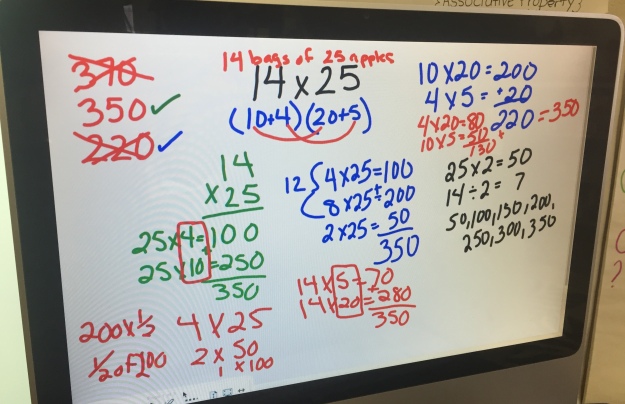

I felt there were a lot more wonderings out there than there was a need for them to write to a specific prompt, so I asked them to journal about things they were wondering about or wanted to try out some more.
I popped in and grabbed a few journals before the end of the day. Most were not finished their thoughts, but they have more time set aside on Wednesday to revisit them since they had to move into other things once I left.
What interesting beginnings to some conjecturing!
Number Talk Karaoke
It is always so fun when I have the chance to hang out with my #MTBoS friends in person! This summer Max was in town, so I not only got to have lunch with him but also meet his amazing wife and puppy! Of course, during lunch, we chatted a lot about the math work we are doing with teachers and some of the routines we are finding really valuable in their classrooms. From these two topics of conversation, Number Talk Karaoke emerged.
We both agreed that while Number Talks are invaluable in a classroom, it can be challenging to teach teachers how to use them in the classrooms. As much as we could model Number Talks during PD and show videos of them in action, it is still not the same as a teacher experiencing it for themselves in their classroom with their students. There is so much to be said for practicing all of the components that are so important during the facilitation with your own students.
That conversation then turned into two questions: What are these important components? and How do we support teachers in these areas? We discussed the fact that there are many books on mathematical talk in the classroom to support the work of Number Talk implementation, however the recording of student explanations during a Number Talk is often left to chance. What an important thing to leave to chance when students often write mathematics based on what they see modeled. We brainstormed ways teachers could practice this recording piece together, in a professional development setting, where students were not available.
Enter Number Talk Karaoke.
During Number Talk Karaoke, the facilitator:
- Plays an audio recording of students during a Number Talk.
- Asks teachers to record students’ reasoning based solely on what they hear students saying.
- Pair up teachers to compare their recordings.
- Ask teacher to discuss important choices they made in their recording during the Number Talk.
Max and I decided to get a recording and try it out for ourselves. So, the next week, I found two of the 3rd grade teachers in my building who were willing to give it a go!
They wanted to try out the recording piece themselves, so they asked me to facilitate the Number Talk. They sat in the back of the room, with their backs to the students and SMARTBoard so they could not see what was happening. All they had in front of them was a paper with the string of problems on it.
Before seeing our recording sheets below, try it out for yourself. In this audio clip of the Number Talk, you will hear two students explain how they solved the first problem, 35+35. The first student explains how he got 70 and the second student explains how he got 80.
Think about:
- What do you think was really important in your recording?
- What choices did you have to make?
- What question(s) would you ask the second student based on what you heard?
The talk went on with three more problems that led to many more recording decisions than the ones made in just those two students, but I imagine you get the point. I have to say, when I was facilitating, I tried to be really clear in my questioning knowing that two others were trying to capture what was being said. That makes me wonder how this activity could be branched out into questioning as well!
Here was my recording on the SMARTBoard with the students:

Here are the recordings from the two teachers in the back of the room:


We sat and chatted about the choices we made, what to record and how to record certain things. We also began to wonder how much our school/district-based Number Talk PD impacted the way we record in similar ways.
Doesn’t this seem like a lot of fun?!? It can be done in person like mine was, or take the audio and try it with a room of teachers, like Max did! <– I am waiting on his blog for this:) Keep us posted, we would love to hear what people do with this!
Which One Doesn’t Belong? Place Value
Since the 3rd grade team begins the year with an addition and subtraction unit in Investigations the teachers and I were having a conversation about how students understand place value. While I don’t see teachers using the HTO (hundreds/tens/ones) chart in their classrooms, students still seem to talk about numbers in that sense. For example, when given a 3-digit number such as 148, students are quick to say the number has 4 tens instead of thinking about the tens that are in the 100. I think a lot of this is because of how we as teachers say these things in our classrooms. I know I am guilty of quickly saying something like, “Oh, you looked at the 4 tens and subtracted…” when doing computation number talks, which could lead students to solely see the value of a number by what digit is sitting in a particular place.
We thought it would be interesting to get a vibe of how this new group of 2nd graders talked about numbers since their first unit deals with place in terms of stickers. A sheet of stickers is 100, a strip of stickers is 10 and then there are the single stickers equal to 1.
I designed a Which One Doesn’t Belong? activity with four numbers: 45, 148, 76, 40
I posted the numbers, asked students to share which number they thought didn’t belong, and asked them to work in groups to come up with a reason that each could not belong. Below is the final recording of their ideas:

I loved the random equation for 148 that emerged and the unsureness of what numbers they would hit if they counted by 3’s or 4’s. One student was sure she would say 45 when she counted by 3’s and was sure she would not say 76 or 40, but unsure about the 148. I wrote those at the bottom for them to check out later.
Since the teacher said she was good on time, I kept going. I pulled the 148 and asked how many tens were in that number. I was not surprised to see the majority say 4, but I did have 3 or 4 students say 14. As you can see below a student did mention the HTO chart, with tallies, interesting.

As students shared, I thought about something Marilyn Burns tweeted a week or so ago…

So, I asked the students to do their first math journal of the school year (YEAH!):
“For the students who answered 14, what question did you answer?
“For the students who answered 4, what question did you answer?
After the students shared, I revisited the Hundreds, Tens, Ones chart. I put a 14 in the tens column, 8 in the ones column, and asked if that was right. The light bulbs and confusion was great! It was as if I had broken all rules of the HTO chart! Then I put a 1 in the hundreds, 3 in the tens, and they worked out the 18. I look forward to seeing them play around with this some more and wonder if when they go to subtract something 148-92, they can think 14 tens -9 tens is 5 tens.
I had to run out because I was running out of time, but snagged three open journals as I left! (I especially love the “I Heart Math” on the second one!



3rd Grade Dot Image
The third grade team is planning for a dot image number talk that focuses on this standard:
“Apply properties of operations as strategies to multiply and divide.2Examples: If 6 × 4 = 24 is known, then 4 × 6 = 24 is also known. (Commutative property of multiplication.) 3 × 5 × 2 can be found by 3 × 5 = 15, then 15 × 2 = 30, or by 5 × 2 = 10, then 3 × 10 = 30. (Associative property of multiplication.) Knowing that 8 × 5 = 40 and 8 × 2 = 16, one can find 8 × 7 as 8 × (5 + 2) = (8 × 5) + (8 × 2) = 40 + 16 = 56. (Distributive property.)”
Before this talk the students have been doing work with equal groups and are moving into array work with the arranging chairs activity in Investigations. They have also been doing dot images with smaller groups and have noticed the commutative property as arranging the same dots into different-sized groups.
These are the three images we are playing around with and anticipating which would would draw out the most interesting strategies based on the properties. We are thinking of having a journal entry afterwards to see if students make any connections between the strategies.
So if you feel like playing around with some dot images and doing some math, I would love anyone’s thoughts on which image you would choose and why!
The start of my planning….
My new thoughts on these images and responses…
After chatting with a few friends yesterday and thinking about which image would elicit the most expressions that could allow students to see some connections between the properties of operations, I am thinking about some changes to the images (in orange).
In image 1, I am wondering if we should split each group of 8 into fours but leave a bigger space between the top four groups and bottom four groups. It may allow students to better see the 4’s and then group them as 8’s and at the same time thinking about “doubling” the top group to get the total because of symmetry. They could then explore ideas like (4 x 4) + (4 x 4) = 4 x 4 x 2 or (4 x 2) x 4 = (4 x 4) x 2 [associative property] or 8 x 4 = (4×4) + (4 x 4) [distributive property] or any fun mix of them. If we leave it as it is, I think it may be hard to move them past 4 x 8, skip counting by 8’s or using 2’s.
In the second image, I love the structure of it but am wondering how students could use that 4 in the middle aside from just adding it on each time? Will we just end up with a lot of expressions with “+4” at the end? I am wondering what would happen if we adding an extra group of four next to it? Would students see the structure of a 5 and double it in some way? (5×4)x2 = 10 x 4 or 5x(2×4)=(5×4)x2 [associative] or 5 x 8 = 10 x 4 [doubling/halving] or 2×4 + 2×4 + 2×4 + 2×4 + 2×4 = 10 x 4
Then what question to pose at the end? Do we ask them to freely choose two expressions and explain how they are equal? or Do we choose the two we want them to compare? Do we have the dot image printed at the top of the page for them to use in their entry?
So much to think about..
~Kristin
3rd Grade Dot Image Number Talk
Since the 3rd graders are entering their multiplication unit, I find it the perfect time for some dot images!! I used the image below as a quick image in which I ask them to think about how many dots they saw and how they saw them. Quick images are so great for pushing students to visualize the dots and move beyond counting by ones and twos. I flashed the image for about 3 seconds, gave students time to think, and then gave them one more quick look at the image to check and/or revise their thinking.
They all saw 20, however the way they the 20 varied a lot and the conversation was amazing from there! Here is how our board ended up…
Recording is something that I am always working on, making truly representative of the students’ thinking. The first thinking was adding groups of four to get 16 and then the additional middle 4 to arrive at 20. The second was skip counting, so I asked the student to do that for me and how they knew to stop at 20. He said he knew it was 5 groups of 4 so he needed to stop after 5 fours. Then I wrote under that “5 groups of 4.” From there a student jumped on that and said that was the same as 5 x 4, because they were talking about that the day before in class.
Then, the thing I was hoping happened, happened. A student said she did 4 x 5 because that was easier. I wrote it down and, of course, ask if that is the same thing? We began on open discussion and they agreed it was the same answer but the picture is not the same. I asked how it changes and a student told me to move a dot to the middle of each of the outside fours to make fives. I drew the arrow and then one student said that is like division, 4 ÷ 4 because you are splitting that 4 between the 4 groups. I let that sit for those not ready for that yet.
The last strategy was counting by twos so I had him skip count for me and recorded that. I asked if we had an equation to match that thinking and got 10 x 2. At that point, I was ready for them to do some algebraic reasoning.
So I wrote 5 x 4 = 10 x 2 and asked them if that was true or false. They unanimously agreed yes so I asked them how they could prove that and to write what they noticed and/or wondered about it. Here are their whiteboard work:
This one showed the 5×4=4×5 to me but I loved the notice so much:
This one was an interesting decomposition of the 4 to show where the two tens are coming from in 2 x 10:
This was a beautiful notice and wonder on the groups changing and wondering if this is with every multiplication problem….how AWESOME?!:
This one required a conversation because I couldn’t really understand it. The movement of dots made two groups of five to make the ten they said, but it was more their noticing/wondering that I want to explore more with them:
Oh my goodness, how much do I love this mention of al(l)gebra in here and then the notice about the half of 10 is 5 and 2 is half of 4…this could have some potential conjecture-making in future talks:
This one is incredibly hard to understand and I am not even sure I completely do, but I love how she used one image to “make” the other:
This student started with decomposing the four (I know we need to think about that equal sign later) but then moved to talking about ten frames. He said if I put two ten frames on top of one another (one attached under the other) I can see five fours (vertically). Then he said he drew them side by side and he saw 2 tens. HOLY COW!
What an amazing conversation with this group! Today I posed them with a few of these noticings and wonderings and asked them to pick one and see if it always worked and why. I didn’t have time to snap pics of their journals but all I can say is 3.5 x 10 came up…so I will have to blog that this weekend!
All of this K-5 work is so exciting and it is so amazing to hear and see all of the great teaching and learning going on around the building!
-Kristin

